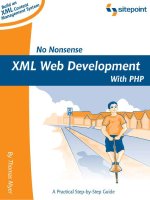Dreamweaver CS5.5 Mobile and Web Development with HTML5, CSS3, and jQuery pptx
Bạn đang xem bản rút gọn của tài liệu. Xem và tải ngay bản đầy đủ của tài liệu tại đây (11.42 MB, 284 trang )
Dreamweaver CS5.5 Mobile
and Web Development with
HTML5, CSS3, and jQuery
Harness the cutting edge features of Dreamweaver for
mobile and web development
David Karlins
BIRMINGHAM - MUMBAI
Dreamweaver CS5.5 Mobile and Web Development
with HTML5, CSS3, and jQuery
Copyright © 2011 Packt Publishing
All rights reserved. No part of this book may be reproduced, stored in a retrieval
system, or transmitted in any form or by any means, without the prior written
permission of the publisher, except in the case of brief quotations embedded in
critical articles or reviews.
Every effort has been made in the preparation of this book to ensure the accuracy
of the information presented. However, the information contained in this book is
sold without warranty, either express or implied. Neither the author, nor Packt
Publishing, and its dealers and distributors will be held liable for any damages
caused or alleged to be caused directly or indirectly by this book.
Packt Publishing has endeavored to provide trademark information about all of the
companies and products mentioned in this book by the appropriate use of capitals.
However, Packt Publishing cannot guarantee the accuracy of this information.
First published: September 2011
Production Reference: 1160911
Published by Packt Publishing Ltd.
Livery Place
35 Livery Street
Birmingham B3 2PB, UK.
ISBN 978-1-84969-158-1
www.packtpub.com
Cover Image by Asher Wishkerman ()
Credits
Author
David Karlins
Reviewers
Chad Adams
Nelson Therrien
Acquisition Editor
Wilson D'souza
Development Editor
Neha Mallik
Technical Editors
Kavita Iyer
Azharuddin Sheikh
Project Coordinator
Srimoyee Ghoshal
Proofreader
Mario Cecere
Indexer
Rekha Nair
Graphics
Valentina D'silva
Production Coordinator
Shantanu Zagade
Cover Work
Shantanu Zagade
About the Author
David Karlins is a consultant, writer, and teacher on digital graphics and
interactive design solutions. He has written or co-authored some fty books,
professional instruction videos, and apps on web design, vector graphic design,
digital photography, sports photography, project management, digital video,
and animation.
David Karlins' consulting clients have ranged from Hewlett Packard to the
Himalayan Fair, from AAA Health Insurance to the Association of Alternative
Newsweeklies.
David Karlins is the author of Adobe Creative Suite 5 Web Premium How-Tos: 100
Essential Techniques, (Adobe Press), Adobe Dreamweaver CS4 How-Tos: 100 Essential
Techniques (Adobe Press), Adobe lllustrator CS4 How-Tos: 100 Essential Techniques
(Adobe Press). He is also the author of PC Magazine Guide to Printing Great Digital
Photos (PC Magazine Press), Build Your Own Web Site (McGraw Hill), Adobe Illustrator
Gone Wild (Wiley), and Enhancing a Dreamweaver Web Site with Flash Video: Visual
QuickProject Guide (Peachpit).
Thanks to Wilson D'souza, Srimoyee Ghoshal, Priya Mukherji, and
the entire management and staff at Packt Publishing. I would also
like to thank my agent Margot Maley Hutchison.
About the Reviewers
Chad Adams is a graduate of University of Central Missouri with a B.F.A. in
Commercial Art in Graphic Design, and has been a professional web developer
and user experience designer for over seven years. He has developed websites and
mobile applications for iOS, Android, and Windows Phone 7 as well.
In order to know more about Chad, visit his website at:
/>My amazing wife, Heather, was always so patient with my late
nights studying and working and I want to thank her for her faithful
support during my career. Lastly, I offer my regards to my friends,
family, and thanks to all those who have supported me in any
respect during the completion of the project.
Nelson Therrien has computer degrees in both multimedia and programming. He
is an ACE (Adobe Certied Expert) with Dreamweaver and has many Brainbench
certications (HTML, XHTML, Dreamweaver, Flash, Web design, Photoshop,
and so on).
Most of his time is spent in teaching and developing web applications and dynamic
forms. He is teaching at Eliquo, Canada's biggest Apple and Adobe authorized
training center. He is responsible for everything that revolves around the Web
at the Montreal ofce.
You could see him if you take a course on Dreamweaver, Flash, ActionScript, Flex,
ColdFusion, HTML5, CSS3, XML, JavaScript, jQuery, PHP, LiveCycle Designer, or
accessibility and standards on the Web. He also touched some ASP, .NET, Java, SQL,
Photoshop, Fireworks, and Illustrator.
He also gave a conference for the launch of Adobe CS5 and CS5.5 in Canada as an
Eliquo representative.
He is the father of three young children.
As a way to relax, he is constantly reading and searching to improve his skills and
knowledge, and he can nd some time to play Canada's national game: hockey!
He is a goaltender on his own and coaches his two sons.
I would like to thank Craig Boassaly, Eliquo's president, and the
entire team at Eliquo for making my teaching job so much fun.
I would also want to thank my wife, who has the job of taking care of
our three angels when I am too busy to help her. Moreover, I would
like to thank my three kids, Josué, Isaac, and Kaïla for putting so
much sunshine in my life.
www.PacktPub.com
Support files, eBooks, discount offers and more
You might want to visit www.PacktPub.com for support les and downloads related to
your book.
Did you know that Packt offers eBook versions of every book published, with PDF and
ePub les available? You can upgrade to the eBook version at www.PacktPub.com and
as a print book customer, you are entitled to a discount on the eBook copy. Get in touch
with us at for more details.
At www.PacktPub.com, you can also read a collection of free technical articles, sign up
for a range of free newsletters and receive exclusive discounts and offers on Packt books
and eBooks.
Do you need instant solutions to your IT questions? PacktLib is Packt’s online digital
book library. Here, you can access, read and search across Packt’s entire library of books.
Why Subscribe?
• Fully searchable across every book published by Packt
• Copy and paste, print and bookmark content
• On demand and accessible via web browser
Free Access for Packt account holders
If you have an account with Packt at www.PacktPub.com, you can use this to access
PacktLib today and view nine entirely free books. Simply use your login credentials for
immediate access.
Table of Contents
Preface 1
Chapter 1: Creating HTML5 Pages in Dreamweaver 5
HTML5 and Dreamweaver CS5 in the world of web design 6
HTML5—the cutting edge of web design 6
HTML4.1, XHTML, and HTML5 7
Compatibility issues with HTML5 8
HTML5 and Dreamweaver CS5.5 9
Dreamweaver generates code 9
Dreamweaver—catching up to HTML5 11
An introduction to HTML5 layout elements 11
The evolution of HTML layout elements 12
Phase 1: Tables 12
Phase 2: CSS DIV tags 13
Phase 3: HTML5 layout elements 15
Meet the HTML5 layout elements 15
Dreamweaver's HTML5 Pack and design elements 16
Detecting or installing the HTML5 Pack in Dreamweaver 17
Creating a Dreamweaver site 19
Generating new pages from layouts using the HTML5 templates 21
Examining the generated HTML5 layout 23
Toggling between related files 23
Code, Split, and Design views 24
Dissecting design elements with the Inspect Mode 25
Saving a layout as a web page 26
Recipe: Creating and saving a 3-column HTML5 page 27
Summary 29
Table of Contents
[ ii ]
Chapter 2: Customizing HTML5 Layout–Content and Look 31
Customizing layouts – An overview 32
Embedding content where it belongs 32
Dissecting format 32
Editing content in HTML5 page layout elements 34
HTML text tags versus HTML5 layout elements 34
Organizing content in containers 35
Utilizing Split view for editing content 36
Adding articles and sections 37
Identifying and selecting HTML5 layout elements 38
Copying, pasting, and deleting HTML5 Elements 39
Identifying style rules 40
HTML5 layout elements require styles 40
Examining CSS associated with HTML5 layouts 42
Customizing HTML tag rules 43
Making quick changes to styles in the CSS styles panel 44
The CSS rules definition dialog 45
Editing type styles 45
Editing backgrounds 46
Preview with apply 46
Saving customized HTML5 layouts 47
Recipe: Customize content and look of an HTML5 page 48
Summary 50
Chapter 3: Customizing HTML5 Layout Elements 51
HTML5 layout and browser compatibility challenges 53
Which browsers support HTML5 layout elements? 53
Using CSS to solve browser issues 53
The magic of display:block 54
Disabling a CSS rule 55
Global HTML5 layout element attributes 58
Working with backgrounds 58
Defining size, margins, and padding 60
Assigning a page size 61
Margins versus padding 61
Element padding versus content margins 62
Positioning with float 62
Customizing HTML5 elements 63
Back to the future: ID and class styles 64
Layout with class styles 64
The role of ID styles 65
Recipe: Customizing the HTML5 page layout 65
Table of Contents
[ iii ]
Recipe: Customizing the size and position for header,
footer, nav, and aside 66
Customizing links in the nav element 69
Summary 74
Chapter 4: Building HTML5 Pages from Scratch 75
Dreamweaver CS5 and HTML5 76
Building an HTML5 page from the top 77
HTML5 structural elements 77
Creating a CSS file 79
Using HTML5 to make content accessible 83
HTML5 layout strategy 85
Using code hints 86
Adding header, header nav, and hgroup 87
Navigation within a header 87
Organizing header content with hgroups 87
Creating articles and sections 88
Adding aside content 90
Creating a footer 91
Adding metadata 92
Defining an address 92
Figures and captions 93
Indicating date and time 93
Recipe Part 1: Build a style sheet for an HTML5 page layout 94
Recipe Part 2: Build an HTML5 layout from scratch 97
Summary 101
Chapter 5: Defining and Implementing Multiscreen
Previews and Media Queries 103
Web design for a multimedia web world 104
CSS3 and Media Queries 105
Styling for mobile devices and tablets 106
Pr
eviewing with the Multiscreen Preview 107
Generating a Media Query in Dreamweaver 109
Building alternative style sheets 110
A 3-step protocol for preparing to generate a Media Query 110
Assigning styles to different media 111
Formatting CSS files for Media Queries 113
Caution: Don't delete style rules 115
Styling for mobile devices 115
Troubleshooting for Apple i-Gadgets 117
Exercise: Defining a Media Query for a cell phone 119
Summary 122
Table of Contents
[ iv ]
Chapter 6: Applying CSS3 Effects and Transforms 123
New in CSS3: Effects and transforms 124
Compatibility challenges 125
CSS3 styles in Dreamweaver's HTML5 Pack 128
CSS3 effects 130
Opacity 131
Border radius 133
Shadows 136
Box shadow 136
Text shadow 137
Text outline 138
CSS3 transforms 139
When to use transforms 140
How to generate transition coding in Dreamweaver 140
Resizing with scale 141
Moving with translate 142
Applying rotation 143
Creating a skew transition 144
Other CS3 transform effects 145
Compound transforms 145
Interactive effects and transforms 145
Effects and JavaScript 146
Interactivity with the :hover pseudo-class 146
Animating CSS3 transforms in Dreamweaver 147
Recipe: Create an animated effect and transform 148
Putting the pieces in place 148
Summary 154
Chapter 7: Embedding HTML5 Audio in Dreamweaver 155
Audio and compatibility 156
Laying the groundwork: HTML5 and page-building 157
Making audio HTML5-ready 157
Audio compression 157
Browser support for audio files 158
Embedding an HTML5 audio element in a Dreamweaver CS5 web page 159
Alternative media options 161
Providing alternative HTML5 audio formats 161
Audio for non-HTML5 browsers 162
Adding play parameters 162
Recipe: Embedding HTML5 audio 164
Summary 166
Table of Contents
[ v ]
Chapter 8: Embedding HTML5 Video in Dreamweaver 167
HTML5 video and Dreamweaver CS5.5 167
Early formats 168
Flash Video (FLV) 169
Apple devices and the web video 170
The wild world of native videos 172
Native video formats 172
Browsers that do NOT support HTML5 172
Preparing an HTML5 video for every scenario 173
Compressing videos for the Web 173
Video compression—open source and proprietary 174
Converting a video to web formats with open source tools 174
Creating an HTML5 video in Adobe Media Encoder CS5. 5 176
Dreamweaver site management for an HTML5 video 178
Defining the HTML5 <video> element 179
Prerequisites 179
Creating the <video> element 180
Defining video attributes 180
Defining video source(s) 181
Alternate video for non-HTML5 environments 182
Putting it all together 182
Testing HTML5 video pages 182
Previewing a video in the Live View 183
Previewing a video in BrowserLab 183
Recipe: Embedding an HTML5 video 184
Summary 187
Chapter 9: Creating Mobile Pages with jQuery 189
Mobile pages – An overview 190
Mobile pages, apps, and jQuery Mobile 192
The status of jQuery Mobile 193
Using jQuery Mobile starter pages 193
Creating mobile pages from Dreamweaver CS5.5 starters 194
Mobile pages in Split view 195
Previewing jQuery Mobile pages in Live view 197
Customizing mobile page content 199
The HTML5 data-role property 199
Data-role pages 199
Customizing page content 201
Customizing content for different data roles 202
Table of Contents
[ vi ]
Adding new jQuery Mobile pages and objects 203
Creating new data-role pages by copying code 203
Creating new data-role pages from the menu 205
Customizing mobile page CSS styles 205
Default jQuery Mobile CSS 207
Editing jQuery Mobile CSS 207
Applying and customizing themes 208
Looking ahead: Generating mobile apps 210
Recipe: Build a mobile web page with jQuery Mobile objects 210
Summary 216
Chapter 10: Adding jQuery Mobile Elements 217
Creating jQuery Mobile pages from scratch 218
Interface options 218
Step 1 – Creating an HTML5 page 219
Step 2 – Inserting a jQuery Mobile "page" 220
Inserting a Layout Grid 223
Defining styles for Layout Grids 225
Designing mobile pages into a collapsible block 226
Building a collapsible block 226
Changing initial block state 227
Changing block data-themes and styles 228
Editing Collapsible Block HTML 229
Adding jQuery form objects 230
Forms in Dreamweaver 231
Creating a jQuery Mobile form 232
Special mobile form fields 234
Inserting a text input field 235
Inserting a slider 235
Inserting a toggle switch 236
Formatting jQuery Mobile Form Fields 236
Recipe: Build a page with collapsible blocks and a form 237
Summary 243
Table of Contents
[ vii ]
Chapter 11: Generating Apps 245
Generating apps from Dreamweaver—an overview 245
Advantage: App vs web page 246
PhoneGap and Dreamweaver CS5.5 247
Configuring application framework(s) 247
The App toolkits 248
Installing the frameworks 248
Defining mobile application settings 249
Building and emulating apps 251
Testing mobile apps on your computer 252
Recipe: Building and emulating a mobile app 254
Summary 256
Index 257
Preface
Dreamweaver is the most powerful and industry-leading web design software that
utilizes innovative web technologies such as HTML5, CSS3, and jQuery for web and
mobile development. These technologies have radically recongured the process of
designing the web content and function in the widest possible range of browsing
environments ranging from desktops to mobile devices.
For experienced Dreamweaver designers and for designers who are new to
Dreamweaver, this book explains in detail how to take advantage of the new features
available in the latest releases of Dreamweaver that add support for HTML5, CSS3,
and jQuery. In addition to this, the book also contains detailed systematic directions
for building mobile applications in Dreamweaver CS5.5.
This book starts off by teaching you to create web pages in Dreamweaver using the
latest technology and approaches—HTML5, CSS3, and JavaScript. It demonstrates
how to create or customize pages with HTML5 layouts and add multimedia to these
pages with HTML5 elements. Then, you will learn to add various CSS3 effects to
web pages. This book also covers different techniques of adding interactivity to
web pages. The later chapters show how to optimize web pages with Dreamweaver
for display in various browsing environments. You will also learn to build jQuery-
based mobile apps from scratch in the later chapters. By the time you nish reading
this book, you will have learned several techniques to use the latest features of
Dreamweaver for web and mobile development.
What this book covers
Chapter 1, Creating HTML5 Pages in Dreamweaver, begins with the exploration of
creating HTML web pages with Dreamweaver CS5.
Chapter 2, Customizing HTML5 Layout—Content and Look, provides information about
customizing both the content and the look of HTML5 pages generated with the
HTML5 Layouts in Dreamweaver.
Preface
[ 2 ]
Chapter 3, Customizing HTML5 Layout Elements, provides an exploration of using new
HTML5 layout elements, including
<header>, <nav>, <article> and <section>,
<aside>, and <footer>.
Chapter 4, Building HTML5 Pages from Scratch, guides you through the process of
building modern standards-complaint pages relying entirely on HTML5 layout tags.
Chapter 5, Dening and Implementing Multiscreen Previews and Media Queries,
guides you through the process of providing media-sensitive content for a
variety of viewports, ranging from large-screen projections of websites to
hand-held devices.
Chapter 6, Applying CSS3 Effects and Transforms, highlights the importance of using
CSS3 to format effects such as drop-shadows, rounded box corners, and opacity
(transparency) along with transforms that change the shape, location, rotation,
and size of objects.
Chapter 7, Embedding HTML5 Audio in Dreamweaver, guides you through the process
of embedding native (browser-based, not plugin-based) audio to web pages using
Dreamweaver CS5.5 tools for HTML5 media.
Chapter 8, Embedding HTML5 Video in Dreamweaver, provides information about
embedding a variety of HTML5-compliant video formats to web pages using
HTML5 and Dreamweaver CS5.5.
Chapter 9, Creating Mobile Pages with jQuery, guides you through the process of
creating jQuery Mobile-based pages—accessible, inviting, animated pages that
work particularly well in mobile devices.
Chapter 10
, Adding jQuery Mobile Elements, provides information about building
jQuery Mobile-based pages from scratch with layout grids, and collapsible blocks.
Chapter 11, Generating Apps, guides you through the process of publishing mobile
apps for iOS (iPhone, iPod Touch, and iPad) and Android devices using new tools in
Dreamweaver 5.5.
What you need for this book
In order to work through this book most effectively, you need access to
Dreamweaver CS5.5 or higher. However, the book includes asides and notes to
enable designers using earlier versions of Dreamweaver, back to Version 3, to take
advantage of Adobe-provided tools for creating HTML5 and CSS3-based websites.
Preface
[ 3 ]
Who this book is for
This book is geared towards experienced Dreamweaver web designers migrating to
HTML5 and jQuery. It also targets web designers new to Dreamweaver who want
to jump with two feet into the most current web design tools and features. While
focused primarily on Dreamweaver CS5.5, the book includes content of value to
readers using older versions of Dreamweaver with directions on installing a
version of Adobe's HTML5 Pack that updates those packages.
Conventions
In this book, you will nd a number of styles of text that distinguish between
different kinds of information. Here are some examples of these styles, and an
explanation of their meaning.
New terms and important words are shown in bold. Words that you see on the
screen, in menus or dialog boxes for example, appear in the text like this: "Doing
this opens the Select Image Source dialog".
Warnings or important notes appear in a box like this.
Tips and tricks appear like this.
Reader feedback
Feedback from our readers is always welcome. Let us know what you think about
this book—what you liked or may have disliked. Reader feedback is important for us
to develop titles that you really get the most out of.
To send us general feedback, simply send an e-mail to
,
and mention the book title via the subject of your message.
If there is a book that you need and would like to see us publish, please
send us a note in the SUGGEST A TITLE form on
www.packtpub.com or
If there is a topic that you have expertise in and you are interested in either writing
or contributing to a book, see our author guide on
www.packtpub.com/authors.
Preface
[ 4 ]
Customer support
Now that you are the proud owner of a Packt book, we have a number of things to
help you to get the most from your purchase.
Errata
Although we have taken every care to ensure the accuracy of our content, mistakes
do happen. If you nd a mistake in one of our books—maybe a mistake in the text or
the code—we would be grateful if you would report this to us. By doing so, you can
save other readers from frustration and help us improve subsequent versions of this
book. If you nd any errata, please report them by visiting
ktpub.
com/support
, selecting your book, clicking on the errata submission form link, and
entering the details of your errata. Once your errata are veried, your submission
will be accepted and the errata will be uploaded on our website, or added to any list
of existing errata, under the Errata section of that title. Any existing errata can be
viewed by selecting your title from />Piracy
Piracy of copyright material on the Internet is an ongoing problem across all media.
At Packt, we take the protection of our copyright and licenses very seriously. If you
come across any illegal copies of our works, in any form, on the Internet, please
provide us with the location address or website name immediately so that we can
pursue a remedy.
Please contact us at
with a link to the suspected
pirated material.
We appreciate your help in protecting our authors, and our ability to bring you
valuable content.
Questions
You can contact us at if you are having a problem with
any aspect of the book, and we will do our best to address it.
Creating HTML5 Pages in
Dreamweaver
This chapter begins our exploration of creating HTML5 web pages with
Dreamweaver CS5. The focus here, and throughout this book is on unleashing the
exciting, powerful HTML features for page layout, animation, media, and design
using HTML5. At the same time, we will of necessity, take a concentrated looks at
basic techniques involved in setting up Dreamweaver websites and basic editing
and formatting tools in Dreamweaver.
After briey introducing HTML5, CSS3, and Dreamweaver CS5, and the way they
work together to create websites, the focus of this chapter will be generating page
layouts in Dreamweaver that avail themselves of HTML5 layout tools. By the end
of this chapter, you will be able to create basic, attractive web pages that use the
improved HTML5 page layout elements. In addition, you will be in a position to
customize those pages with your own content, and formatting, in the next chapter.
In this chapter, we will:
Survey the evolution of HTML5 and understand how it simplies the web
page design
Explore key HTML5 elements used in web page layouts
Understand how Dreamweaver CS5 generates HTML5 web page layouts
Install the HTML5 Pack as an Extension (for Dreamweaver CS5 and older
versions as well)
Create Dreamweaver CS5/HTML5 sites and les
Generate new pages from layouts using the HTML5 templates
Control views
Generate HTML5 page layouts in Dreamweaver
Create a 3-column HTML5 page layout in Dreamweaver
•
•
•
•
•
•
•
•
•
Creating HTML5 Pages in Dreamweaver
[ 6 ]
HTML5 and Dreamweaver CS5 in the
world of web design
We will be working with a few key acronyms in this book and they stand for things,
which are essential to creating innovative websites. So, let's start with introductions:
HTML5 is the latest and most powerful version of the HTML (HyperText
Markup Language). It is the newest and the most powerful language for
creating the basic elements of a web page.
CSS3 is the latest and the most powerful version of CSS (Cascading Style
Sheets—or Style Sheets for short). CSS handles how web pages and
elements on them look.
Dreamweaver CS5 is the most widely used, powerful, and exible tool for
creating the web page content, including HTML5 and CSS3. Thus, the basic
ow of this book will be exploring the key powerful features of HTML5 and
CSS3 and generating those features using Dreamweaver CS5.
Limited CS4 and CS3 functionality: Some, but not all of the features
explored in this book are available in older versions of Dreamweaver
with the HTML5 Pack installed. In general, you can follow the
same steps indicated here for Dreamweaver CS3 and CS4 and take
advantage of those elements of the HTML5 Pack supported by older
versions of Dreamweaver.
HTML5—the cutting edge of web design
I like to describe HTML5 concisely as solving the 3s: simplifying, standardizing,
and styling. Those terms don't embrace everything new in HTML5, but they
highlight key new features and help break down what HTML5 is all about into
digestible chunks.
HTML5 simplies the web design by taking frequently used features, such as
the page layout elements we will explore in this chapter, and dening elements
(previously known as tags) for them. Therefore, for example, instead of every
page designer needing to invent a special batch of code to dene a page
header—a common element in many web pages—HTML5 has added a
standard, pre-set
<header> element.
•
•
•
Chapter 1
[ 7 ]
HTML5 is an attempt to standardize how browsers interpret the page layout code.
Now, an obvious question is, who sets the standards and how standard are they?
The answer in this case is complex, contradictory, and a work in progress. However,
sufce to say that an alignment of the most powerful players on the Web, in
particular the makers of all the major browsers (Safari, Firefox, Chrome, Opera, and
Internet Explorer starting with version 9) have all embraced HTML5, to the point
that a critical mass is either now in place, or emerging quickly. That said, it would be
a long time before everyone browsing the Web is doing so in an HTML5-compliant
browser. Therefore, in the course of this book, we will explore approaches for
providing alternative content for visitors using non-HTML5 browsers.
HTML5 also expands what can be done in web design style, without resorting to
plugins (such as JavaScript or Flash). Many of these additional features are accessed
through CSS3—the latest version of Style Sheet formatting that is an enabling,
co-dependent partner (in a good way!) with HTML5.
HTML4.1, XHTML, and HTML5
HTML5 was preceded by XHTML, and before that, HTML 4 (in various versions).
In some ways, HTML5 is not a continuation on that evolutionary line, but a new
synthesis that stands on both HTML and XHTML.
There is no great need here to clutter our heads with the ways in which HTML5
addresses non-standardization in different previous versions of HTML and
browsing environments, but such housekeeping and standardization is a
signicant contribution of HTML5.
The new features in HTML5 (and the related features in CSS3) are of more interest
for designers.
HTML5's
<video> and <audio> elements provide a much simplied approach to
presenting the online video and audio, without resorting to different and competing
media players (such as Windows Media Player, QuickTime player, or Flash Player).
The new canvas elements open the door to an exciting array of possibilities for
presenting images, interactivity, and media.
Moreover, as we will focus on in this chapter, HTML5 introduces a set of elements
that standardize and simplify the page layout.
Creating HTML5 Pages in Dreamweaver
[ 8 ]
Compatibility issues with HTML5
As HTML5 is new, and emerging, designers obviously want to know whether
elements they create using it (such as video, or page design elements) are
supported in different browsers.
The answer is more complicated than you might think. Different HTML5 elements
are supported in different browsing environments and in different ways. For
example, many (but not all) browsers support HTML5's new
VIDEO element, but
within that grouping of browsers, there is support for different video formats.
In other cases, older browsers support the HTML5 elements, but some of the features
don't work. In general, these elements still work in older browsers and visitors
simply forego nice but non-essential features. For example, an HTML5 e-mail will be
easier to ll out in an HTML5-complaint browser, but will still work as a plain text
eld in older browsers.
This might sound like a messy situation. In some ways it is. However, as I say in
almost every session of my live web design classes, "welcome to the experience."
Compatibility issues with HTML5 are, however, an eminently manageable challenge
that we will address from different angles and with different problems in mind
throughout this book.
Each time we introduce HTML5 elements, we will also look at how to provide
alternatives for visitors viewing the page in a browser that does not support HTML5.
Sometimes, the HTML5 features not supported in non-complaint browsers limit
available features, but do not cause harm. For example, the following screenshot
illustrates the
PLACEHOLDER attribute in HTML5 that displays a "hint" text in a form
eld that vanishes when a visitor begins typing in that eld.
HTML5 allows a placeholder text, in this case, Enter search text here:
In the case of HTML5's placeholder attribute, when this is not supported in a
browser, the form eld simply appears without the placeholder text, as shown
in the following screenshot.









